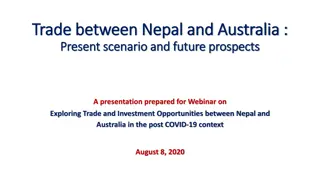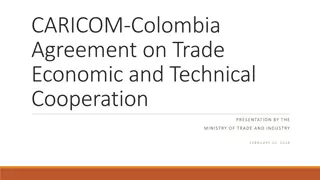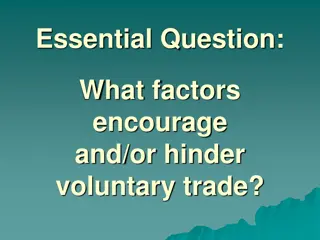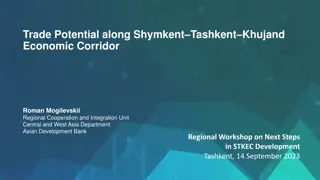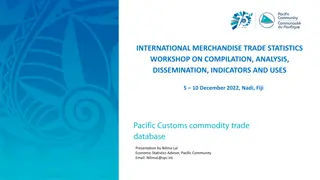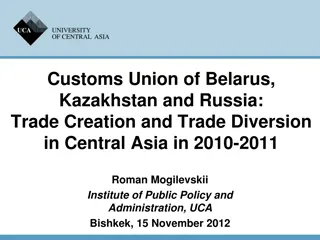Time-Cost Trade-Off
Exploring the concept of time-cost trade-off, this content delves into reasons to reduce project durations, such as avoiding penalties and meeting deadlines, and methods to achieve time reduction like overtime and advanced technology usage. It also discusses how project costs are estimated and provides insights into project crashing techniques.
Download Presentation

Please find below an Image/Link to download the presentation.
The content on the website is provided AS IS for your information and personal use only. It may not be sold, licensed, or shared on other websites without obtaining consent from the author.If you encounter any issues during the download, it is possible that the publisher has removed the file from their server.
You are allowed to download the files provided on this website for personal or commercial use, subject to the condition that they are used lawfully. All files are the property of their respective owners.
The content on the website is provided AS IS for your information and personal use only. It may not be sold, licensed, or shared on other websites without obtaining consent from the author.
E N D
Presentation Transcript
Time-Cost Trade-Off (Time Reduction = Time Compression) (Time Shortening)
Reasons to Reduce Project Durations: To avoid late penalties(or avoid damaging the company s relationship) To realize incentive pay (monetary incentives for timely or early competition of a project To beat the competition to the market to fit within the contractually required time (influences Bid Price) To free resources for use on other projects (complete a project early & move on to another project) To reduce the indirect costs associated with running the project To complete a project when weather conditions make it less expensive (Avoid temporary heating, avoid completing site work during raining season) Many things make crashing a way of life on some projects (i.e. last minutes changes in client specification, without permission to extend the project deadline by an appropriate increment) Shortening the duration is called project crashing
Methods to reduce durations 1. Overtime:Have the existing crew work overtime. This increase the labor costs due to increase pay rate and decrease productivity. Hiring and/or Subcontracting: a) Bring in additional workers to enlarge crew size. This increases labor costs due to overcrowding and poor learning curve. b) Add subcontracted labor to the activity. This almost always increases the cost of an activity unless the subcontracted labor is far more efficient. Use of advanced technology: Use better/more advanced equipment. This will usually increase costs due to rental and transport fees. If labor costs (per unit) are reduced, this could reduce costs. 2. 3.
How project cost is estimated? Practices to Estimate the Project Cost Some company assigns Overhead office as % of direct cost. Most companies don t consider profit as a cost of the job. Cost analysis are completed by using: o [Direct costs + Indirect costs + Company overhead] vs. Budgeted (estimated costs) Similar to each activity, the project as a whole has an ideal (least expensive) duration.
How project is crashed? Specify 2 activity times and 2 costs o1st time/cost combination (D, CD)- called Normal[Normal usual average time, resources] o2nd time/cost combination (d, Cd)- called Crash[Expedite by applying additional resources]
General 2 Steps in Project Crashing In order to speed up any project schedule with a minimum cost, you need to follow these two general steps: 1. Select the Critical Path Activities. 2. Within the critical path activities, select the lowest reduction cost rate Cost Slope to reduce it. In following slides more details on these 2 General Steps
Steps in Project Crashing Basic Steps 1. Compute the crash cost per time period. If crash costs are linear over time: ????? ???? ??? ?????? = ???? ????? (????? ???? ?????? ????) (?????? ???? ????? ????) = 2. Using current activity times, find the critical path and identify the critical activities
Steps in Project Crashing 3. If there is only one critical path, then select the activity on this critical path that (a) can still be crashed, and (b) has the smallest crash cost per period. If there is more than one critical path, then select one activity from each critical path such that (a) each selected activity can still be crashed, and (b) the total crash cost of all selected activities is the smallest. Note that the same activity may be common to more than one critical path. 4. Update all activity times. If the desired due date has been reached, stop. If not, return to Step 2.
Example1: Crashing The Project Critical Path for Milwaukee Paper (A, C, E, G, H) 0 2 2 4 4 7 2 2 3 A 0 C 0 F 6 0 2 2 4 10 13 13 15 2 0 0 4 8 0 4 H 0 Start 0 E 15 13 0 0 4 8 0 3 7 0 3 8 13 3 4 5 B 1 G 0 D 1 1 4 8 8 13 4
Example1: Crashing The Project CALCULATION OF CRAH COST/PERIOD Crash and Normal Times and Costs for Activity B Activity Cost Crash Crash Cost Normal Cost Normal Time Crash Time $34,000 Crash Cost/Wk = $33,000 Crash Cost, Cd $34,000 $30,000 3 1 $4,000 2 Wks = $32,000 = = $2,000/Wk $31,000 $30,000 Normal Normal Cost, CD | 1 | 2 | 3 Time (Weeks) Crash Time, d Normal Time, D Table 3.16 (Frome Heizer/Render; Operation Management)
Example1: Crashing The Project Time (Wks) Cost ($) Normal Activity Normal Crash Crash Cost Critical Per Wk ($) Crash Path? A 2 3 2 4 4 3 5 2 1 1 1 2 2 2 2 1 22,000 30,000 26,000 48,000 56,000 30,000 80,000 16,000 22,750 34,000 27,000 49,000 58,000 30,500 84,500 19,000 750 2,000 1,000 1,000 1,000 500 1,500 3,000 Yes No Yes No Yes No Yes Yes B C D E F G H Table 3.5 (Frome Heizer/Render; Operation Management)
Example2: Crashing Project For the small project shown in the table, it is required to reduce the project duration. A) Reduce by 2 periods. B) Reduce by 5 periods. Normal Crash Activity Precedence Time, day Cost, $ Time, day Cost, $ A B C D E F G H - - 4 8 6 9 4 5 3 7 210 400 500 540 500 150 150 600 3050 3 6 4 7 1 4 3 6 280 560 600 600 1100 240 150 750 4280 A A B,C C E D,F
Example2: Crashing Project Normal Crash Activity Precedence Time, day Cost, $ Time, day Cost, $ 1- develop network A - 4 210 3 280 B - 8 400 6 560 C A 6 500 4 600 D A 9 540 7 600 E B,C 4 500 1 1100 F C 5 150 4 240 G E 3 150 3 150 H D,F 7 600 6 750 3050 4280 9 D 4 6 5 7 A C F H FINISH START 8 4 3 B E G
Example2: Crashing Project 2- calculate times, find critical path 9 4 13 D 2 6 15 4 6 5 7 0 4 4 10 10 15 15 22 A 0 C 0 F 0 H 0 0 4 4 10 10 15 15 22 0 0 0 0 22 22 FINISH START 0 0 0 0 22 22 8 4 3 0 8 10 14 14 17 B 7 E 5 G 5 7 15 15 19 19 22 Activity Total float Free float A 0 0 B 7 2 C 0 0 D 2 2 E 5 0 F G H 0 5 0 5 Project completion time = 22 working days Critical Path: A, C, F, H. 0 0
Example2: Crashing Project 3- calculate cost slope Normal Crash Cost Slope, $/day Activity Precedence Time, day 4 8 6 9 4 5 3 7 Cost, $ 210 400 500 540 500 150 150 600 3050 Time, day 3 6 4 7 1 4 3 6 Cost, $ 280 560 600 600 1100 240 150 750 4280 A B C D E F G H - - 70 80 A A 50 30 B,C C E D,F 200 90 ** 150 Remarks 1- [G can not expedite] 2- lowest slope and can be expedited on critical path is activity (C) WITH 2 periods
Example2: Crashing Project Normal Crash Cost Slope, Reduce 2 periods of activity (C) with increase of cost (2*50) =100 Activity Precedence Time, day Cost, $ Time, day Cost, $ $/day A - 4 210 3 280 70 B - 8 400 6 560 80 C A 6 500 4 600 50 D A 9 540 7 600 30 ES LS E B,C 4 500 1 1100 200 Activity F C 5 150 4 240 90 TF EF LF ** G E 3 150 3 150 9 4 13 Crash limit (d @ cost) H D,F 7 600 6 750 150 D 0 3050 4280 4 13 4 4 5 7 0 4 4 8 8 13 13 20 A 0 C 0 F 0 H 0 0 4 4 8 8 13 13 20 0 0 0 0 20 20 FINISH START 0 0 0 0 20 20 8 4 3 0 8 8 12 12 15 B 5 E 5 G 5 5 13 13 17 17 20 Activity Total float Free float A 0 0 B 5 0 C 0 0 D 0 0 E 5 0 F G H 0 5 0 5 Project completion time = 20 working days Critical Path: A, C, F, H. & A, D, H 0 0
Example2: Crashing Project Normal Crash Cost Slope, Reduce 1 period of activity (A) with increase of cost =70 Activity Precedence Time, day Cost, $ Time, day Cost, $ $/day A - 4 210 3 280 70 B - 8 400 6 560 80 C A 6 500 4 600 50 D A 9 540 7 600 30 E B,C 4 500 1 1100 200 F C 5 150 4 240 90 ** G E 3 150 3 150 9 3 12 H D,F 7 600 6 750 150 D 0 3050 4280 3 12 3 5 7 4 0 3 3 7 7 12 12 19 A 0 C 0 F 0 H 0 0 3 3 7 7 12 12 19 0 0 0 0 19 19 FINISH START 0 0 0 0 19 19 8 4 3 0 8 7 11 11 14 B 4 E 5 G 5 8 12 12 16 16 19 Activity Total float Free float A 0 0 B 4 0 C 0 0 D 0 0 E 5 0 F G H 0 5 0 5 Project completion time = 19 working days Critical Path: A, C, F, H. & A, D, H 0 0
Example2: Crashing Project Normal Crash Cost Slope, Activity Precedence Time, day Cost, $ Time, day Cost, $ $/day Reduce farther 1 period of 2 activities (D,F) with increase of cost (30+90) =120 A - 4 210 3 280 70 B - 8 400 6 560 80 C A 6 500 4 600 50 D A 9 540 7 600 30 E B,C 4 500 1 1100 200 F C 5 150 4 240 90 ** G E 3 150 3 150 8 3 11 H D,F 7 600 6 750 150 D 0 3050 4280 3 11 4 7 3 4 0 3 3 7 7 11 11 18 A 0 C 0 F 0 H 0 0 3 3 7 7 11 11 18 0 0 0 0 18 18 FINISH START 0 0 0 0 18 18 8 4 3 0 8 7 11 11 14 B 3 E 4 G 4 3 11 11 15 15 18 Activity Total float Free float A 0 0 B 3 0 C 0 0 D 0 0 E 4 0 F G H 0 4 0 4 Project completion time = 19 working days Critical Path: A, C, F, H. & A, D, H 0 0
Example2: Crashing Project Normal Crash Cost Slope, Activity Precedence Time, day Cost, $ Time, day Cost, $ $/day Reduce farther 1 period of activity (H) with increase of cost =150 A - 4 210 3 280 70 B - 8 400 6 560 80 C A 6 500 4 600 50 D A 9 540 7 600 30 E B,C 4 500 1 1100 200 F C 5 150 4 240 90 ** G E 3 150 3 150 8 3 11 H D,F 7 600 6 750 150 D 0 3050 4280 3 11 6 3 4 4 0 3 3 7 7 11 11 17 A 0 C 0 F 0 H 0 0 3 3 7 7 11 11 17 0 0 0 0 17 17 FINISH START 0 0 0 0 17 17 8 4 3 0 8 7 11 11 14 B 2 E 3 G 3 2 10 10 14 14 17 Activity Total float Free float A 0 0 B 2 0 C 0 0 D 0 0 E 3 0 F G H 0 3 0 3 Project completion time = 19 working days Critical Path: A, C, F, H. & A, D, H 0 0
Example2: Crashing Project Reduction from 22 to 17 increase to 3490 Normal Crash Cost Slope, Activity Precedence Time, day Cost, $ Time, day Cost, $ $/day A - 4 210 3 280 70 Cycle Activity Time cost Duration Total cost B - 8 400 6 560 80 C A 6 500 4 600 50 0 - 22 3050 D A 9 540 7 600 30 1 C 2 100 20 3150 E B,C 4 500 1 1100 200 F C 5 150 4 240 90 2 A 1 70 19 3220 ** G E 3 150 3 150 H D,F 7 600 6 750 150 3 D,F 1 30+90 18 3340 3050 4280 4 H 1 150 17 3490 3600 3500 3400 Cost 3300 3200 3100 3000 16 17 18 19 20 21 22 23 Project Duration
Example2: Crashing Project Accelerating the Critical and Noncritical path Cost Slope, Normal Crash Activity Precedence Time, day Cost, $ Time, day Cost, $ $/day A - 4 210 3 280 70 B - 8 400 6 560 80 C A 6 500 4 600 50 D A 9 540 7 600 30 E B,C 4 500 1 1100 200 F C 5 150 4 240 90 ** G E 3 150 3 150 H D,F 7 600 6 750 150 3050 4280
How project is crashed? Network Compression Algorithm Determine Normal project duration, and cost. Identify Normal duration Critical Path. For large network, using CRITICALITY THEOREM to eliminate the noncritical paths that do not need to be crashed. Eliminate Activities with having TF > the required project reduction time . Compute the cost slop ????? ???? ??? ?????? = ???? ????? (????? ???? ?????? ????) (?????? ???? ????? ????) =
How project is crashed? Network Compression Algorithm Shortening the CRITICAL ACTIVITIES beginning with the activity having the lowest cost-slope Determine the compression limit (Nil) - Crash Limit, or Nil = Min - Free Float of any of the non critical activities in the parallel paths competing for critical path.* Organize the data as in the following table:
How project is crashed? Network Compression Algorithm Update the project network When a new Critical Path is formed: - Shorten the combination of activity which Falls on Both Critical Paths, OR - Shorten one activity from each of the critical paths. Use the combined cost of shortening both activities when determining if it is cost-effective to shorten the project. At each shortening cycle, compute the new project duration and project cost Continue until no further shortening is possible
How project is crashed? Network Compression Algorithm Tabulate and Plot the Indirect project Cost on the same time- cost graph Add direct and indirect cost to find the project cost at each duration. Use the total project cost-time curve to find the optimum time.
Example 3 38470
Example 3 - Either crash A crash C crash G crash I We have one critical path, A-C-G- I. at cost SR 100/week or at cost SR 200/week or at cost SR 60/week or at cost SR 75/week. 20 23 43 D 4 24 4 47 0 0 12 12 A 27 20 47 G 47 12 59 I 12 8 20 B 20 5 25 E 0 0 12 27 0 47 47 0 59 14 2 22 22 2 27 2@100 5@60 2@75 2@150 1@50 2 12 15 27 C 27 5 32 F 32 13 45 H ES D EF Activity 12 0 27 29 2 34 34 2 47 LS TF LF Crash limit 3@200 1@300 2@40 Cycle #Activity to Shorten 0 1 Can Be Shortened 5 Weeks Shortened 2 Cost per Week 60 Cost for Cycle 120 Project Duration 59 57 Nil Total Cost G 2 36,500 36,620
Example 3 - Either crash A crash C crash I crash F and G crash H and G 2 Now we have two critical paths: A-C-F-H-I and A-C-G- I. at cost SR 100/week or at cost SR 200/week or at cost SR 75/week or at cost SR 360/week or at cost SR 100/week. 20 23 43 D 22 2 45 0 0 12 12 A 27 18 45 G 45 12 57 I 12 8 20 B 20 5 25 E 0 0 12 27 0 47 45 0 55 14 2 22 22 2 27 2@100 3@60 2@75 2@150 1@50 12 15 27 C 27 5 32 F 32 13 45 H ES D EF Activity 12 0 27 27 0 32 32 0 45 LS TF LF Crash limit 3@200 1@300 2@40 Cycle #Activity to Shorten 0 1 2 Can Be Shortened 5 2 Weeks Shortened 2 2 Cost per Week 60 75 Cost for Cycle 120 150 Project Duration 59 57 55 Nil Total Cost G I 2 36,500 36,620 36,770
Example 3 - Either crash A crash C crash F and G crash H and G 2 Now we have two critical paths: A-C-F-H-I and A-C-G- I. at cost SR 100/week or at cost SR 200/week or at cost SR 360/week or at cost SR 100/week. 20 23 43 D 22 2 45 0 0 12 12 A 27 18 45 G 45 10 55 I 12 8 20 B 20 5 25 E 0 0 12 27 0 45 45 0 55 14 2 22 22 2 27 2@100 3@60 2@150 1@50 0 12 15 27 C 27 5 32 F 32 13 45 H ES D EF Activity 12 0 27 27 0 32 32 0 45 LS TF LF Crash limit 3@200 1@300 2@40 Cycle #Activity to Shorten 0 1 2 3 Can Be Shortened 5 2 2 Weeks Shortened 2 2 2 Cost per Week 60 75 100 Cost for Cycle 120 150 200 Project Duration 59 57 55 53 Nil Total Cost G I A 2 36,500 36,620 36,770 36,970
Example 3 - Either crash C crash F and G crash H and G Now we have two critical paths: A-C-F-H-I and A-C-G- I. at cost SR 200/week or at cost SR 360/week or at cost SR 100/week. 18 23 41 D 2 20 2 43 0 0 10 10 A 25 18 43 G 43 10 53 I 10 8 18 B 18 5 23 E 0 0 10 25 0 43 43 0 53 12 2 20 20 2 25 3@60 0 2@150 1@50 0 10 15 25 C 25 5 30 F 30 13 43 H ES D EF Activity 10 0 25 25 0 30 30 0 43 LS TF LF Crash limit 3@200 1@300 2@40 Cycle #Activity to Shorten 0 1 2 3 4 Can Be Shortened 5 2 2 2 Weeks Shortened 2 2 2 2 Cost per Week 60 75 100 60+40 Cost for Cycle 120 150 200 200 Project Duration 59 57 55 53 51 Nil Total Cost G I A 2 2 36,500 36,620 36,770 36,970 37,170 H, G
Example 3 - Either crash C and B crash F, G and B Now we have three critical paths; A-C-F-H-I, A-C-G- I, and A-B-D-I. at cost SR 350/week or at cost SR 510/week. 18 23 41 D 18 0 41 0 0 10 10 A 10 8 B 18 25 16 41 G 41 10 51 I 18 5 E 23 0 0 0 10 10 0 18 25 0 41 41 0 51 20 2 25 2@150 1@60 0 1@50 0 10 15 25 C 25 5 F 30 30 11 41 H ES D EF Activity 10 0 25 25 0 30 30 0 41 LS TF LF Crash limit 3@200 1@300 0 Cycle #Activity to Shorten 0 1 2 3 4 5 Can Be Shortened 5 2 2 2 2 Weeks Shortened 2 2 2 2 2 Cost per Week 60 75 100 60+40 150+200 Cost for Cycle 120 150 200 200 700 Project Duration 59 57 55 53 51 49 Nil Total Cost G I A 2 2 36,500 36,620 36,770 36,970 37,170 37,870 G, H B, C
Example 3 Final Results 16 23 39 D 16 0 39 0 0 10 10 A 10 6 16 B 23 16 39 G 39 10 49 I 16 5 21 E 0 0 10 10 0 16 23 0 39 39 0 49 18 2 23 0 0 1@50 1@60 0 10 13 23 C 23 5 28 F 28 11 39 H ES D EF Activity 10 0 23 23 0 28 28 0 39 LS TF LF Crash limit 1@200 1@300 0 Direct Cost Indirect Cost Project Duration 59 57 55 53 51 49 Cycle # Total Cost 0 1 2 3 4 5 36500 36620 36770 36970 37170 37870 7375 7125 6875 6625 6375 6125 43875 43745 43645 43595 43545 43995
Example 3 Final Results Project Optimal Duration 50000 45000 40000 35000 Direct Cost Indirect cost Total Cost 30000 Cost (SR) 25000 20000 15000 10000 5000 0 48 49 50 51 52 53 54 55 56 57 58 59 60 Project Duration (Week)
CASE WORK Data on small maintenance project is given as below: On completion, the project will give a return of SR110/day. Using time-cost trade-off method, how much would you like to compress the project for maximizing the return (ignore the Indirect cost effect)? Show all calculations. Activity Depends on A B B C D, E F, G Normal Crash Time 6 days 4 days 5 days 8 days 10 days 7 days 3 days 6 days 7 days Cost SR700 400 650 625 200 500 600 300 350 Time 4 days 4 days 4 days 5 days 7 days 5 days 3 days 5 days 4 days Cost SR800 400 700 700 350 700 600 400 425 A B C D E F G H I





